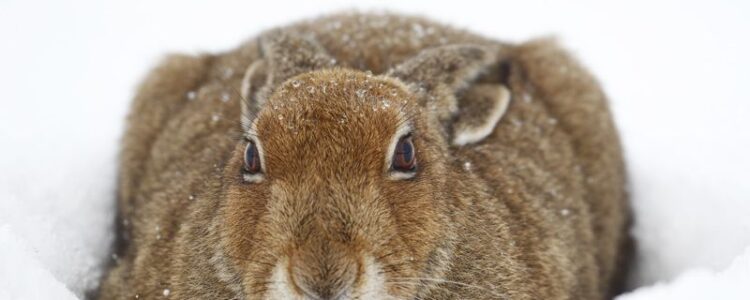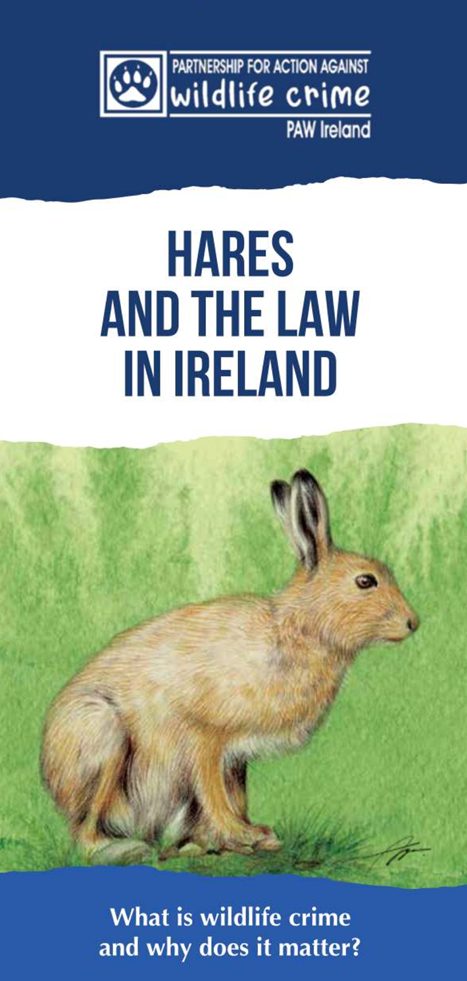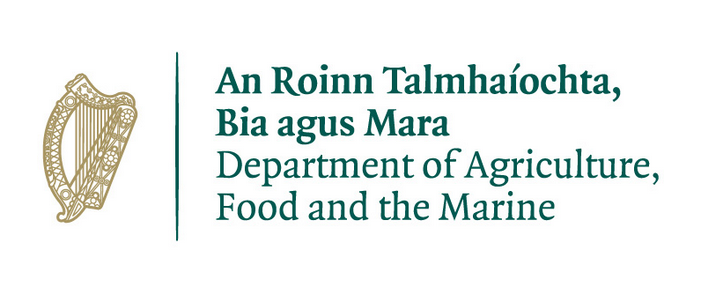
Hare & Rabbit
Irish Hare Lepus - timidus hibernicus / Rabbit Oryctolagus - cuniculus
Irish Hare
Lepus timidus hibernicus
The Irish hare is one of our true native mammals and is endemic only to Ireland. It is a genetically distinct, and uniquely Irish, variant of the Mountain hare found in Britain and Europe. However, unlike its close relation, the Irish hare may be found throughout Ireland from mountainside to coastal grassland and is not just confined to mountain regions.
Fur colour varies widely in Irish hares and can range from a light ‘blond’ through brown to the russet red described in textbooks. The coat may also vary throughout the year, developing white patches but rarely turning completely white, exceptionally during the extremely cold winters.
Apart from a local population of introduced European ‘brown’ hares in mid-Ulster, this species is generally absent in Ireland. Fur, and especially tail, colour are not reliable indicators of species identification.
Larger than rabbits, Irish hares have black tips on the ears, white on both upper and lower surfaces of the tail and long back legs that give them a distinctive ‘loping walk’. Hares do not live in burrows but rely on the cover of dense vegetation, making a ‘nest’ of flattened grass called a form.
Irish hares may breed throughout most of the year, having two or three litters with an average litter size of two. Leverets are born fully furred with eyes open. The mother hare ‘hides’ them in vegetation and returns only once each night to feed them. It is normal to see a leveret on its own and it should never be removed from the wild unless it is in imminent danger.
The Irish hare population has undergone a dramatic decline over the last 100 years and numbers are low. It is widely believed that changes in land use and agriculture have contributed to their demise. Overgrazing, overstocking, mechanised grass cutting and increased production of silage all have a detrimental effect on hares and their habitat. Adults are sensitive to disturbance and the young may be killed by grass cutting.
Since the 1930’s it has been known that disturbance and handling can cause critical, often fatal, levels of stress in hares.
Rabbit
Oryctolagus cuniculus
Rabbits are thought to have been introduced to Ireland by the Normans in the 12th century and are now common throughout the island. They were kept in enclosed warrens and exploited as a food supply by early settlers and monasteries. The rabbit’s Latin name, cuniculus, means underground passage and these adaptable animals may be found anywhere they can make burrows, although they avoid wet areas.
Well known for their ability to reproduce, rabbits can have several litters each year from the age of around three months. With an average litter size of six, these high numbers are balanced by a very high mortality rate. Rabbits don’t often live for more than 3 years. Over 90% die in the first year of life, and most of these in the first three months (domestic rabbits may live 10 years or more).
Rabbit kittens are born naked and blind in a special burrow, or stop, made by the doe. Weaned at four weeks they leave this burrow to take their place in the rabbit community. Although they have been domesticated for centuries, rabbits still retain many qualities of their wild ancestors and it is possible for a doe of any domestic breed to give birth to a baby with the natural agouti fur colour.
The general population of rabbits in Ireland remains relatively stable although numbers fluctuate locally as a result of two virulent diseases, myxomatosis and Rabbit Haemorrhagic Disease (RHD). These were introduced into wild rabbit populations to control their numbers. Myxomatosis is spread by rabbit fleas but RHD can be highly contagious. Domestic rabbits are also vulnerable to both of these highly infectious diseases and owners can arrange effective vaccination for their pets at their local veterinary practice.
When numbers are high, rabbits are often regarded as pests.
Although they have no legal protection in Ireland, rabbits do have a very important place in the food chain and make a major contribution to the diet of many other, often rarer or protected species.
Hare Crimes
Hare species are protected by law in the Republic of Ireland.
The Irish hare is a priority species and is legally protected in Ireland, initially under the Game Preservation Act (1930), then by the Wildlife Acts 1976 to 2012.
It is listed on Appendix III of the Berne Convention, Annex V(a) of the EC Habitats Directive (92/43/EEC) and as an internationally important species in the Irish Red Data Book.
Unless authorised to do so under a valid licence or permission granted by the Minister for Arts, Heritage and the Gaeltacht under the Wildlife Acts 1976 to 2012 it is unlawful to:-
- Hunt a hare during a period specified in a hares (open seasons) order (26th September – 28th February) and in a place to which the order applies other than by means of
- shooting with firearms with valid firearms certificate/licence or
- hunting with packs of beagles and harriers (both are breeds of dog) or
- coursing at regulated coursing matches
- Hunt hares by any means on any day or days which are not specified in a hares order
- Course a hare other than at a regulated coursing match registered with the Irish Coursing Club
- Trap or net hares for coursing
- Hunt a hare at any time during any period beginning one hour after sunset and ending one hour before sunrise
- Hunt a hare with any lamp, image intensifiers or any sighting device for night shooting
- Hunt or disturb for the purpose of hunting a hare by means of a mechanically-propelled vehicle , whether it is being so propelled or stationary
- Hunt a hare with poisonous or stupefying bait
- Enter on land with hunting equipment for the purpose of hunting hares without the permission of the owner/occupier of the land
- Wilfully interfere with or destroy the breeding place or resting place of a hare
- Be in possession of a hare (alive or dead) other than a lawfully acquired specimen
- Sell, keep for sale, offer for sale a hare, other than the sale by a person of live hares to a coursing club affiliated to the Irish Coursing Club
A few examples of licences or permission which may be applied for under Wildlife Acts 1976 to 2012:
Wildlife (Wild Mammals) (Open Seasons) Orders 2005 to 2012 allows hares to be hunted at certain times of the year.
Section 42 Damage by hares, Permission to stop serious damage to crops, forestry, livestock, etc by protected wild animals permission can be applied for by the owner or occupier of property to scare, capture or kill a hare which is causing serious damage to agricultural crops, a woodland or a forest plantation.
Section 23(6) Licence to keep an injured or disabled wild animal with the purpose of rehabilitating it for release back into the wild.
Section 34 and 32 Licences to catch hares, mark / tag them, and then to use them for hare coursing
HARE COURSING
Hare coursing in Ireland is regulated and controlled under the Greyhound Industry Acts, 1958 and 1993, which are administered by the Department of Agriculture, Food and the Marine
Hare coursing is the pursuit of live hares with greyhounds, in which dogs are tested on their ability to run, overtake and turn a hare.
It is a competitive ‘sport’ (according to the Irish Coursing Club) / ‘bloodsport’ (according to animal welfare proponents).
Two forms of coursing are practised in Ireland –
Enclosed/Park coursing; mainly greyhound racing stadiums, where the dogs are muzzled
Open coursing; an open field that hares have been herded into from a 2 or 3 mile radius by “beaters”, where the dogs are not muzzled.
The Irish Coursing Club – ICC (the governing body in coursing) take hares for coursing under licence granted by the Minister of Arts, Heritage & the Gaeltacht under the Wildlife Acts 1976 to 2012. The licence allow coursing clubs to capture with nets, around 5,500 hares from the wild and use them as live lures for dogs at 80 or so meetings during a coursing season, which extends over a 22 week period from September 25th to March 1st. The Minister attaches to the licence 22 separate conditions in relation to the taking, keeping and subsequent release of the hares.
Coursing, as practised by the ICC, was introduced to Ireland in 1813 by British Army officers stationed at The Curragh.
The Republic of Ireland, Spain and Portugal are the only EU countries to allow enclosed hare coursing.
Rabbit Crimes
The rabbit is not a protected species under the Wildlife Acts 1976 to 2012, which basically means that you can hunt and kill it without having to apply for a licence or permission to do so.
The Wildlife Acts do however make provisions that wild animals and wild mammals (which includes the rabbit) may not be hunted by various means.
Accordingly the following provision of the Wildlife Acts makes it unlawful to:
- Hunt a rabbit by means of a trap, snare or net unless they stand approved for the purposes of this section by virtue of regulations under this section (see Wildlife Act 1976 (Approved Traps, Snares and Nets) Regulations 2003)
- Hunt a rabbit by means of any poisonous, poisoned or stupefying bait
- Enter on any land with a firearm or other hunting equipment for the purpose of hunting or trapping a rabbit without the permission of the owner or the occupier or some other person entitled to enjoy sporting rights over the land
Issues of cruelty to animals (including rabbits) are dealt with in the provisions of the Animal Health and Welfare Act 2013:
Section 12
- Makes it an offence to – (a) do, or fail to do, anything or cause or permit anything to be done to an animal that causes unnecessary suffering to, or endangers the health and welfare of an animal, or (b) neglect, or be reckless, regarding the health and welfare of an animal
In this Act “Unnecessary Suffering” means, in relation an animal, pain, distress or suffering (whether physical or mental) that in its kind or degree, or in its object, or in the circumstances in which it occurs, is unreasonable or unnecessary
Wildlife Licensing Unit,
National Parks and Wildlife Service,
Department of Housing, Local Government and Heritage
National Parks and Wildlife Service
90 King Street North
Dublin 7
D07 N7CV
Email: wildlifelicence@npws.gov.ie
Call: 01 888 2000
Recording evidence at the Crime Scene
Assessing whether a criminal offence has taken place may not always be straight forward and other possibilities such as natural deaths, predation and legal hunting should be considered.
If you come across a wildlife crime scene or a dead bird or object that may be related to a wildlife crime, every piece of information is – or might be – important, but it needs to be recorded properly and accurately for the authorities to have a chance of prosecuting an offender.
Before you do anything else it is very important that:
- You do NOT put yourself in danger by approaching anyone you suspect of committing a crime – they may be violent and/or aggressive.
- You do NOT touch any dead birds or animals. They may be poisoned baits or victims of poisoning. Many poisons (e.g. Carbofuran) are extremely dangerous to us as well as wildlife in even very small amounts and can be absorbed through the skin.
- You do NOT disturb the scene by walking around unnecessarily – small pieces of evidence (cigarette ends, footprints, the marks left by a spade etc) may be lost or trampled into the mud or grass.
- You do NOT move any items at the scene – unless asked to do so or an animal or human”s welfare is/may be compromised by leaving it at the scene.
- You do NOT mark the site (e.g. with a white plastic bag) Although being able to see a marker from a distance might sound like a good idea, it will also alert an offender that someone has been at the site and they might go back and remove evidence.
- You do NOT do anything illegal yourself – leave crime to the criminals!
Record the date and time
- Record the transport
Do this as soon as possible, as suspects can be traced from the registration number
Photograph/write down any vehicle registration numbers that are or might be related to the incident. It is legal to record a registration number if you suspect that the vehicle has been or may be used in a crime. - Record the person
Recording the offender’s face is important of course, but their clothing, the bags they’re carrying, the equipment they’re using are all important too. - Record the scene
Take photographs or video of the scene using a mobile phone or camera etc (or make as accurate a sketch as possible). - If possible try to cover any items, perhaps with vegetation, to make them safe; but make sure you don’t disturb the crime scene in the process!
- If photographing an object, try to put something beside it for scale (e.g. a coin or notebook) providing it won’t disturb the crime scene.
- Record the location
It is particularly important to record locations accurately (apps that provide GPS data are available for most smartphones)
In an urban area note the address or a description of the location. In the countryside take wide angle photographs of any landmarks; a tree, a distinctive fence line, a hill. - Even if in doubt take a photograph and email it to the National Parks and Wildlife Service WildlifeEnforcement@npws.gov.ie
Reporting a hare crime
To report suspected illegal hare activity contact the National Parks & Wildlife Service
Tel: (01) 888 2000
Contact numbers for your local NPWS Conservation Ranger HERE
If you can’t reach NPWS personnel call An Garda Síochána:
If the crime is in progress or about to happen, or if the offender is still at the scene or has just left call 999 or 112
If the event is finished then contact the National Bureau of Criminal Investigation on envi.wildlife.crime@garda.ie and call your local Garda Station (Garda Stations Directory) or the Garda Confidential Telephone Number 1800 666 111
If the animal is alive and is injured, also, call a wildlife rehabilitator/vet from the contacts page of Irish Wildlife Matters

